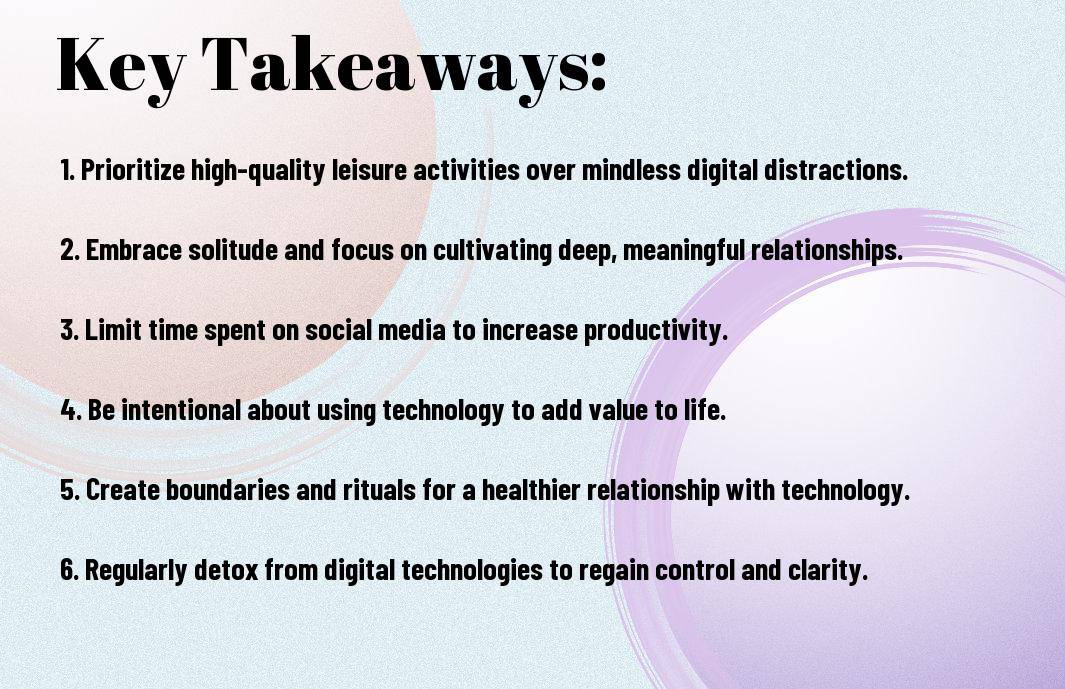
Newsletter Subscribe
Enter your email address below and subscribe to our newsletter

Enter your email address below and subscribe to our newsletter

Digital Distractions – Cal Newport! If you find yourself constantly feeling overwhelmed by the never-ending stream of notifications, emails, and social media updates vying for your attention, you’re not alone. In his book “Digital Minimalism,” Cal Newport presents a powerful strategy to help individuals regain control over their digital lives and reduce digital distractions. By implementing Newport’s principles of minimalism, individuals can promote more intentional use of technology and ultimately enhance their overall well-being.

Some people believe that digital minimalism is all about reducing screen time, but it goes beyond that. It is a philosophy that advocates for being intentional about the digital tools and technologies we use, focusing on the benefits they bring while minimizing distractions and negative impacts. Key principles of digital minimalism include being mindful of how we spend our time online, prioritizing quality over quantity in our digital activities, and cultivating a healthier relationship with technology.
An important aspect of digital minimalism is the philosophy behind choosing a focused life in a noisy world. In today’s hyper-connected society, we are bombarded with incessant distractions that can pull us away from what truly matters. Digital minimalism empowers individuals to filter out the noise, prioritize deep work and real-world connections, and reclaim control over their attention and time.
Definition: Embracing digital minimalism involves making deliberate choices about the tools and technologies we allow into our lives, focusing on what adds value and eliminating unnecessary noise.
Plus, embracing digital minimalism can lead to increased productivity, enhanced creativity, and improved overall well-being as individuals learn to use technology as a tool rather than being controlled by it.

Despite the countless benefits that technology has brought into our lives, there is a growing concern about the negative impact of excessive digital consumption. The constant bombardment of notifications, the temptation to constantly check our devices, and the addictive nature of social media have led to a decrease in our ability to focus, increased levels of stress, and a general feeling of being overwhelmed.
Lives today are heavily intertwined with technology. From smartphones and laptops to smart home devices and wearable technology, digital tools have become an integral part of our daily routines. While these advancements have undoubtedly made our lives more convenient and connected, they have also introduced a new set of challenges.
On the flip side, the consequences of excessive digital consumption are becoming more apparent. Studies have linked heavy technology use to increased feelings of loneliness, anxiety, and depression. The constant need for validation through likes and comments on social media has led to a rise in low self-esteem and body image issues, especially among young people.
Digital minimalism offers a solution to these issues by promoting a more intentional and mindful approach to technology use. By decluttering our digital lives, setting boundaries with our devices, and prioritizing real-world experiences, we can regain control over our attention and focus on what truly matters.

Once again, let’s research into the core strategies of digital minimalism proposed by Cal Newport to help reduce digital distractions and reclaim your time and attention in the noisy digital world.
One key strategy in digital minimalism is to initiate a digital declutter. This involves taking a break from optional technologies in your life, such as social media, online video streaming, or digital entertainment. By temporarily stepping back from these digital distractions, you can gain clarity on how you truly want to spend your time and prioritize meaningful activities.
Digital minimalism emphasizes the importance of cultivating high-quality leisure activities that enrich your life. Instead of mindlessly scrolling through social media feeds or binge-watching television shows, focus on activities that bring fulfillment and meaning. Engaging in hobbies, spending time in nature, or pursuing creative endeavors can help you lead a more fulfilling and balanced life.
Digital minimalism encourages individuals to be deliberate in choosing leisure activities that align with their values and bring genuine joy. By consciously selecting activities that foster personal growth and connection, you can cultivate a more meaningful and satisfying lifestyle.
Plus, embracing high-quality leisure activities can lead to enhanced well-being, increased productivity, and improved mental health. By prioritizing activities that nourish the mind and soul, you can experience greater fulfillment and happiness in your daily life.
Unlike other strategies that focus on simply managing digital distractions, digital minimalism, as proposed by Cal Newport, emphasizes reducing the overall presence of technology in our lives to improve focus and well-being.
Implementing digital minimalism in daily life starts with setting clear technology rules for yourself. Define specific guidelines on when and how you will use digital devices, such as designating certain times for checking emails or social media. By establishing boundaries and sticking to them, you regain control over your digital habits and prevent technology from dominating your time and attention.
Implementing embrace boredom Digital minimalism encourages embracing boredom as a way to free yourself from constant stimulation. By allowing yourself to experience moments of boredom without immediately turning to digital distractions, you give your mind the opportunity to wander, be creative, and reflect. This practice enables you to reconnect with your thoughts and emotions, leading to increased mindfulness and clarity in daily life.
Plus, optional When embracing boredom, consider engaging in activities that promote creativity and self-reflection, such as journaling, meditation, or simply spending time in nature. These activities can help you cultivate a deeper understanding of yourself and your surroundings, fostering personal growth and emotional well-being.

Your journey towards digital minimalism may be hindered by the Fear of Missing Out (FOMO), which is a common challenge in today’s hyper-connected world. FOMO can cause anxiety and stress as you try to keep up with the constant stream of information and activities on social media and other digital platforms. To combat FOMO, remind yourself that you are in control of your time and attention. Set boundaries for your digital usage and prioritize activities that truly add value to your life.
The key to sustaining digital minimalism over time is consistency and mindfulness. Make a conscious effort to regularly evaluate your digital habits and adjust them as needed. Engage in activities that bring you joy and fulfillment outside of the digital realm to reduce the temptation of reverting to old habits. Remember that digital minimalism is a lifestyle choice that requires ongoing commitment and effort.
To further support your journey in sustaining digital minimalism over time, consider finding a supportive community or accountability partner who shares your values. Having someone to discuss challenges and successes with can help keep you motivated and accountable in your pursuit of a more intentional and focused digital life.
FOMO can lead to impulsive digital behavior that distracts you from your priorities and goals. By acknowledging and addressing your FOMO tendencies, you can cultivate a more mindful and intentional relationship with technology, ultimately leading to a more fulfilling and balanced life.
To fully comprehend the impact of Digital Minimalism, one must understand the personal benefits of adopting this strategy. By minimizing digital distractions, individuals can regain control over their time and attention. Reducing the constant bombardment of notifications and messages allows for increased focus and productivity. With fewer distractions, individuals can engage in deep, meaningful work and cultivate a sense of fulfillment from their accomplishments. Furthermore, digital minimalism promotes a healthier relationship with technology, leading to reduced feelings of anxiety and overwhelm.
To examine deeper into the impact of Digital Minimalism, we must explore the societal implications of this movement. Mentally, widespread adoption of digital minimalism can lead to a reduction in stress and improved overall well-being. As individuals become more intentional in their technology usage, they can prioritize real-life interactions and cultivate deeper connections with others. This shift may ultimately result in a more harmonious and balanced society, where genuine human connections are valued over virtual interactions.
Enhanced awareness of the negative effects of excessive digital consumption may lead to a societal shift towards healthier tech habits. As more people embrace Digital Minimalism, we could see a decrease in social isolation, improved mental health outcomes, and a greater sense of presence in everyday life.
Ultimately, Cal Newport’s strategy of digital minimalism offers a powerful approach to reducing digital distractions and reclaiming control over our lives. By intentionally curating our digital tools and activities, we can focus on what truly matters to us and live more intentionally. This approach not only helps us boost productivity, but also improves our well-being by reducing stress and increasing our capacity for deep work and meaningful connections.
Cal Newport: How Digital Minimalism Can Help You Take Back Control of Your Life
A: Digital Minimalism is a philosophy introduced by Cal Newport that advocates for reducing digital distractions and focusing on what truly matters in life.
A: Digital Minimalism is important because it helps individuals reclaim their time and attention from the constant barrage of digital distractions, allowing them to focus on deep work, personal relationships, and activities that bring true fulfillment.
A: You can practice Digital Minimalism by being intentional about the technology you use, setting boundaries on your digital consumption, decluttering your digital life, and prioritizing activities that align with your values.
A: The benefits of practicing Digital Minimalism include increased productivity, improved mental well-being, better focus and concentration, stronger relationships, and a greater sense of fulfillment and purpose.
A: You can declutter your digital life by deleting apps and accounts you no longer use, unsubscribing from unnecessary emails, organizing your digital files and data, and setting limits on the time you spend on digital devices.
A: Yes, practicing Digital Minimalism can have a positive impact on mental health by reducing feelings of anxiety, overwhelm, and FOMO (fear of missing out), and promoting mindfulness, presence, and a greater sense of control over your life.
A: You can create a Digital Minimalist lifestyle by defining your digital priorities, establishing digital boundaries, being mindful of your digital consumption, engaging in analog activities, and regularly evaluating and adjusting your digital habits to align with your values and goals.